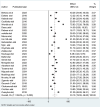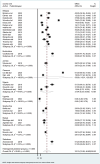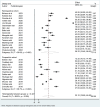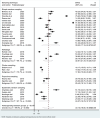Incidence and predictors of mortality among low birth weight neonates in Africa: a systematic review and meta-analysis
- PMID: 40735603
- PMCID: PMC12303992
- DOI: 10.3389/fped.2025.1458871
Incidence and predictors of mortality among low birth weight neonates in Africa: a systematic review and meta-analysis
Abstract
Background: In Africa, the burden of low birth weight (LBW) neonatal mortality remains substantial, yet comprehensive evidence is lacking, with varied and inconclusive findings from primary studies. This systematic review and meta-analysis aimed to assess the pooled incidence and predictors of LBW neonatal mortality in Africa.
Methods: In accordance with the Preferred Reporting Items for Systematic Reviews and Meta-Analyses (PRISMA) guidelines, we systematically searched PubMed, EMBASE, Cochrane Library, African Journals Online, Web of Science, Google Scholar, and Google for relevant studies. The Newcastle Ottawa Scale was used to assess study quality. Heterogeneity and publication bias were evaluated using the I 2 statistic and Egger's test. A random-effects model was applied due to significant heterogeneity, with pooled incidence and 95% confidence intervals (CIs) calculated. Subgroup and sensitivity analyses explored sources of heterogeneity.
Results: This meta-analysis included 28 studies involving 56,775 LBW neonates. The pooled incidence of LBW neonatal mortality in Africa was 33.1% per 100 person-years (95% CI: 19.54-46.65), with substantial heterogeneity (I 2 = 99.9%, P < 0.001). Predictors associated with LBW neonatal mortality included extremely low birth weight (PHR = 4.37, 95% CI: 2.62-7.29), lack of antenatal care follow-up (PHR = 2.84, 95% CI: 1.21-6.67), perinatal asphyxia (PHR = 1.73, 95% CI: 1.38-2.16), necrotizing enterocolitis (PHR = 2.80, 95% CI: 2.03-3.86), preterm birth (PHR = 3.17, 95% CI: 1.88-5.35), respiratory distress syndrome (PHR = 1.87, 95% CI: 1.57-2.23), sepsis (PHR = 2.04, 95% CI: 1.59-2.63), lack of kangaroo mother care (PHR = 5.29, 95% CI: 2.76-10.16), maternal diabetes mellitus (PHR = 2.74, 95% CI: 1.87-4.01), and maternal HIV infection (PHR = 4.47, 95% CI: 2.06-9.67).
Conclusions: This study highlights a concerning high incidence of LBW neonatal mortality in Africa. Strategies targeting these predictors, such as improving antenatal care, promoting kangaroo mother care, and managing maternal health conditions like diabetes and HIV, could substantially reduce LBW neonatal mortality in the region. Policymakers and healthcare providers should prioritize these interventions to mitigate the high burden of LBW neonatal mortality and improve neonatal health outcomes across Africa.
Systematic review registration: identifier, CRD42024560375.
Keywords: Africa; incidence; low birth weight; meta-analysis; mortality; neonates; predictors.
© 2025 Mengstie, Teklehaimanot, Gebeyehu, Abemie, Ayfokru, Dessie, Tefera and Girma.
Conflict of interest statement
The authors declare that the research was conducted in the absence of any commercial or financial relationships that could be construed as a potential conflict of interest.
Figures








Similar articles
-
Gestational weight gain below instead of within the guidelines per class of maternal obesity: a systematic review and meta-analysis of obstetrical and neonatal outcomes.Am J Obstet Gynecol MFM. 2022 Sep;4(5):100682. doi: 10.1016/j.ajogmf.2022.100682. Epub 2022 Jun 18. Am J Obstet Gynecol MFM. 2022. PMID: 35728780
-
Multiple-micronutrient supplementation for women during pregnancy.Cochrane Database Syst Rev. 2017 Apr 13;4(4):CD004905. doi: 10.1002/14651858.CD004905.pub5. Cochrane Database Syst Rev. 2017. Update in: Cochrane Database Syst Rev. 2019 Mar 14;3:CD004905. doi: 10.1002/14651858.CD004905.pub6. PMID: 28407219 Free PMC article. Updated.
-
All-cause mortality and infection-related outcomes of hospital-initiated kangaroo care versus conventional neonatal care for low-birthweight infants: a systematic review and meta-analysis.Lancet Child Adolesc Health. 2025 Jul;9(7):470-483. doi: 10.1016/S2352-4642(25)00130-0. Epub 2025 May 26. Lancet Child Adolesc Health. 2025. PMID: 40441171
-
Intravenous immunoglobulin for preventing infection in preterm and/or low-birth-weight infants.Cochrane Database Syst Rev. 2004;(1):CD000361. doi: 10.1002/14651858.CD000361.pub2. Cochrane Database Syst Rev. 2004. Update in: Cochrane Database Syst Rev. 2013 Jul 02;(7):CD000361. doi: 10.1002/14651858.CD000361.pub3. PMID: 14973955 Updated.
-
Multiple-micronutrient supplementation for women during pregnancy.Cochrane Database Syst Rev. 2015 Nov 1;2015(11):CD004905. doi: 10.1002/14651858.CD004905.pub4. Cochrane Database Syst Rev. 2015. Update in: Cochrane Database Syst Rev. 2017 Apr 13;4:CD004905. doi: 10.1002/14651858.CD004905.pub5. PMID: 26522344 Free PMC article. Updated.
References
-
- Sutan R, Mohtar M, Mahat AN, Tamil AM. Determinant of low birth weight infants: a matched case control study. Open J Prev Med. (2014) 4(3):91–9. 10.4236/ojpm.2014.43013 - DOI
-
- Targets WGN. Low Birth Weight Policy Brief. Geneva: World Health Organization. (2014). p. 7.
-
- Geberu DM, Baffa LD, Hagos A, Tiruneh MG, Teshale G, Tafere TZ, et al. Pooled prevalence and factors of low birth weight among newborns in the top 20 countries with the highest infant mortality: analysis of recent demographic and health surveys. BMJ Open. (2025) 15(4):e098090. 10.1136/bmjopen-2024-098090 - DOI - PMC - PubMed
-
- Fleischer NL, Merialdi M, van Donkelaar A, Vadillo-Ortega F, Martin RV, Betran AP, et al. Outdoor air pollution, preterm birth, and low birth weight: analysis of the world health organization global survey on maternal and perinatal health. Environ Health Perspect. (2014) 122(4):425–30. 10.1289/ehp.1306837 - DOI - PMC - PubMed
Publication types
LinkOut - more resources
Full Text Sources

